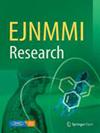Potential application of [18F]AlF-PSMA-11 PET/CT in radioiodine refractory thyroid carcinoma
IF 3.1
3区 医学
Q1 RADIOLOGY, NUCLEAR MEDICINE & MEDICAL IMAGING
引用次数: 0
Abstract
Patients diagnosed with radioiodine refractory (RAI-R) thyroid carcinoma (TC) have a significantly worse prognosis than patients with radiosensitive TC. These refractory malignancies are often dedifferentiated, hindering the effectiveness of iodine-based imaging. Additionally, the role of metabolic imaging using [18F]FDG PET/CT is also limited in these cases, making adequate staging of RAI-R TC challenging. Recent case series have shown promising results regarding the role of the prostate-specific membrane antigen (PSMA) in TC. In this study we explored the value of [18F]AlF-PSMA-11 PET/CT in RAI-R TC. In this phase II study, lesions detected on [18F]AlF-PSMA-11 PET were compared to findings from [18F]FDG PET/CT. Additionally, the serologic soluble prostate-specific membrane antigen (sPSMA) was measured using ELISA. PSMA-expression on tumor tissue in any available resection specimens was analysed with an immunostainer. Eight patients were included, with a total of 39 identified lesions based on PET imaging. [18F]AlF-PSMA-11 PET identified 30 of 39 lesions, and [18F]FDG PET identified 33 lesions, leading to a detection rate of 76.9% and 84.6%, respectively. Interestingly, while nine lesions were solely visualized on [18F]FDG, six were uniquely seen on [18F]AlF-PSMA-11 PET. While sPSMA was immeasurable in all female patients, no correlation was found between sPSMA in male patients and disease-related factors. In five out of eight patients immunohistology showed PSMA expression on the primary tumor. Although not all lesions could be visualized, [18F]PSMA-11 PET identified multiple lesions imperceptible on [18F]FDG PET. These results display the potential additional diagnostic role of PSMA-targeted imaging in patients with RAI-R TC. Trial registration number No. EudraCT 2021-000456-19.18F]AlF-PSMA-11 PET/CT 在放射性碘难治性甲状腺癌中的潜在应用
被诊断为放射性碘难治性(RAI-R)甲状腺癌(TC)患者的预后明显差于放射性敏感性甲状腺癌患者。这些难治性恶性肿瘤通常已发生分化,阻碍了碘成像的有效性。此外,使用[18F]FDG PET/CT 进行代谢成像在这些病例中的作用也很有限,因此对 RAI-R TC 进行充分分期具有挑战性。最近的病例系列显示,前列腺特异性膜抗原(PSMA)在前列腺癌中的作用很有希望。在这项研究中,我们探讨了[18F]AlF-PSMA-11 PET/CT 在 RAI-R TC 中的价值。在这项 II 期研究中,[18F]AlF-PSMA-11 PET 检测到的病变与[18F]FDG PET/CT 的结果进行了比较。此外,还使用酶联免疫吸附法测定了血清可溶性前列腺特异性膜抗原(sPSMA)。使用免疫印迹仪分析切除标本中肿瘤组织的 PSMA 表达。共纳入了八名患者,根据 PET 成像共确定了 39 个病灶。在 39 个病灶中,[18F]AlF-PSMA-11 PET 发现了 30 个,[18F]FDG PET 发现了 33 个,检出率分别为 76.9% 和 84.6%。有趣的是,[18F]FDG PET 只能发现 9 个病灶,而[18F]AlF-PSMA-11 PET 则能发现 6 个病灶。虽然所有女性患者的 sPSMA 都无法测量,但男性患者的 sPSMA 与疾病相关因素之间并无关联。八名患者中有五名患者的免疫组织学检查显示原发肿瘤上有 PSMA 表达。虽然并非所有病灶都能被观察到,但[18F]PSMA-11 PET 发现了[18F]FDG PET 无法察觉的多个病灶。这些结果显示了 PSMA 靶向成像在 RAI-R TC 患者中的潜在诊断作用。试验注册号:EudraCT 2021-000456-19。
本文章由计算机程序翻译,如有差异,请以英文原文为准。
求助全文
约1分钟内获得全文
求助全文
来源期刊

EJNMMI Research
RADIOLOGY, NUCLEAR MEDICINE & MEDICAL IMAGING&nb-
CiteScore
5.90
自引率
3.10%
发文量
72
审稿时长
13 weeks
期刊介绍:
EJNMMI Research publishes new basic, translational and clinical research in the field of nuclear medicine and molecular imaging. Regular features include original research articles, rapid communication of preliminary data on innovative research, interesting case reports, editorials, and letters to the editor. Educational articles on basic sciences, fundamental aspects and controversy related to pre-clinical and clinical research or ethical aspects of research are also welcome. Timely reviews provide updates on current applications, issues in imaging research and translational aspects of nuclear medicine and molecular imaging technologies.
The main emphasis is placed on the development of targeted imaging with radiopharmaceuticals within the broader context of molecular probes to enhance understanding and characterisation of the complex biological processes underlying disease and to develop, test and guide new treatment modalities, including radionuclide therapy.
 求助内容:
求助内容: 应助结果提醒方式:
应助结果提醒方式:


